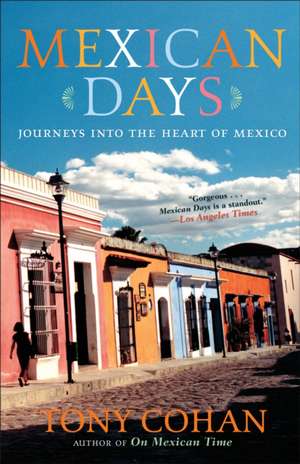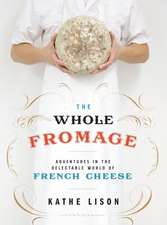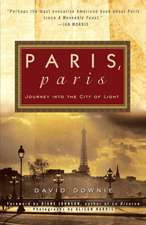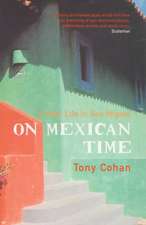Mexican Days: Journeys Into the Heart of Mexico
Autor Tony Cohanen Limba Engleză Paperback – 31 mar 2007
Told with the intimate, sensuous insight and broad sweep that captivated readers of On Mexican Time, Mexican Days is set against a changing world as Cohan encounters surprise and adventure in a Mexico both old and new: among the misty mountains and coastal Caribbean towns of Veracruz; the ruins and resorts of Yucatán; the stirring indigenous world of Chiapas; the markets and galleries of Oaxaca; the teeming labyrinth of Mexico City; the remote Sierra Gorda mountains; the haunted city of Guanajuato; and the evocative Mayan ruins of Palenque. Along the way he encounters expatriates and artists, shady operatives and surrealists, and figures from his past.
More than an immensely pleasurable and entertaining travel narrative by one of the most vivid, compelling travel voices to emerge in recent years, Mexican Days is both a celebration of the joys and revelations to be found in this inexhaustibly interesting country and a searching investigation of the Mexican landscape and the grip it is coming to have in the North American imagination.
Preț: 110.88 lei
Nou
Puncte Express: 166
Preț estimativ în valută:
21.22€ • 22.07$ • 17.52£
21.22€ • 22.07$ • 17.52£
Carte disponibilă
Livrare economică 25 martie-08 aprilie
Preluare comenzi: 021 569.72.76
Specificații
ISBN-13: 9780767920919
ISBN-10: 0767920910
Pagini: 275
Dimensiuni: 134 x 203 x 17 mm
Greutate: 0.21 kg
Editura: BROADWAY BOOKS
ISBN-10: 0767920910
Pagini: 275
Dimensiuni: 134 x 203 x 17 mm
Greutate: 0.21 kg
Editura: BROADWAY BOOKS
Notă biografică
TONY COHAN is the author of On Mexican Time, the memoir Native State (a Los Angeles Times Notable Book of the Year), and the novels Opium and Canary (a New York Times Notable Book of the Year). His articles, essays, and reviews have appeared in the New York Times, the Washington Post, the Los Angeles Times, and Condé Nast Traveler. He divides his time between Mexico and California.
Extras
1.
Once Upon a Time in Mexico
So what do you make of this?” said Xavier.
I watched, from behind a cordon of yellow police tape, Antonio Banderas in a mariachi outfit, and Salma Hayek in far less, dangling from cables affixed to the rooftop of the Hotel San Francisco in San Miguel de Allende’s central plaza, el jardín. Walkie-talkies crackled in Spanish and English. A utility van edged slowly past with a card taped to its windshield reading ONCE UPON A TIME IN MEXICO.
“¡Acción!”
A volley of fake gunshots burst forth; cameras droned. As the pair descended on the cables in the burnished early twilight, kicking the air, I realized they weren’t Antonio and Salma at all but stunt doubles. “Cut!” I heard in English. Then I saw, over the heads of the gawkers, the real Johnny Depp, pale and slight, emerging from Xavier’s dad’s restaurant with his lady, Vanessa Paradis, on his arm. Willem Dafoe swung into view, followed by Cheech Marin. Was that Mickey Rourke across the plaza? Rubén Blades? Girls’ screams signaled the arrival of the true Banderas, Melanie Griffith close beside him; then la Salma herself with her swain, Edward Norton.
Cast and crew had been shooting for months in and around San Miguel, Xavier said. Local nerves were frayed. First flutters of pride and curiosity had given way to resentment. Shopkeepers were up in arms at street blockades preventing access to their stores. An old gringo had cursed out a camera crew some days earlier, to the amusement of the local town paper, Atención—as if he had any more or less right to be here than they did. Hungry locals, hoping to hire on for a few days’ work as extras in a bullfight scene, complained about low pay and dry sandwiches. News had leaked out that Melanie Griffith refused to leave the room while a woman masseuse attended to Antonio.
“They’ve rented our town,” Xavier said. “Or maybe I should say they’ve bought it.”
Banderas and director Robert Rodriguez, of El Mariachi fame, hoping to mollify criticism for “not giving something back to the community,” were going to show Spy Kids for free in the plaza that night for the benefit of local youth. The massive movie screen had been installed in front of the Museo Ignacio Allende, obscuring the statue of San Miguel’s native son and revolutionary hero, and folding metal chairs were stacked against the old wall across from the Parroquia, the parish church. Banderas would speak to the kids beforehand, thank the community, and introduce the film.
It was a late summer afternoon, the town walls flaring brick red as the sun tipped the mountains across the Guanajuato Plain—golden time for the cameras, no doubt. Over and over the couple dropped like spiders from the Hotel San Francisco roof, accompanied by flurries of gunshots.
“They’ve been shooting the same scene for three days,” Xavier said bleakly.
I’d been away for a while, doing necessary things, all the while dreaming of sweet return. I suppose I should have been amused at the irony: former refugee from the movie capital of the world finds himself tripping over cable wires, kliegs, and booms trying to get back to his house in this once-remote old town in the central Mexican highlands. But it had been a tough trip: two weeks earlier, the attacks on the World Trade Center and the Pentagon. Leaving LAX for Mexico that morning had been like passing through an armed camp. This was hardly the soft landing I’d imagined on the flight down.
We slipped away from the flower sellers, bullhorns, and stargazers crowding the portales around the plaza and headed down Calle Umarán. Passing a gaggle of tourists in front of Restaurant La Mama, Xavier said ruefully, “If I see another Frida Kahlo tote bag, I’m getting out my gun.”
Laughing, we came to my street, where we exchanged an abrazo and agreed to meet up later.
Ducking under police tape, I bore my luggage down Calle Flor in the soft, spreading twilight. This had been a favored foot route from the old Hotel Ambos Mundos, where I stayed when I first came here, to the shady bowers of the Parque Juárez: then the steep climb beyond to El Chorro, the beautiful old waterworks and site of the town’s founding in 1521 by the friar San Miguel. Calle Flor, a three-block ribbon of rough cobbles sloping southwest from the town center, retained a mix of large and small homes behind its high, lime-washed walls. Not the fanciest street in town, but a pretty one, and if it showed up in an occasional postcard, video, or Mexican soap opera, this was only fitting tribute.
As the commotion of the jardín receded, I glimpsed beyond the curving descent a swatch of enameled sky, darkening blue to ebony, crosshatched with black grackles and white egrets winging their way home. Above the hill’s rim, where the road called El Caracol twists down into the town, steely cumuli gathered for their quick, violent nightly assault, cleansing the cobbles and cooling the summer evening before ceding the sky to starlight. The once-barren hillside had filled in with homes over the years, the tangle of electrical wires obstructing its view now buried underground (a public fiasco in which the manhole covers kept caving in, sending unwary pedestrians to the Hospital de la Fe with broken legs or worse).
When I first knew Calle Flor, there were few shops or restaurants along it. Now the first block hosted a bookstore, an art gallery, two popular café-restaurants, a hair salon, a realty office, a home furnishing shop, two jewelers’ boutiques, and a house-techno pulque bar late at night. The next block, where we lived, remained residential but for an old jeweler who kept sketchy hours and a neighborhood tiendita run by a family who sold soft drinks and small provisions; and where an Italian restaurant had flowered one long-ago summer and we danced the nights away to salsa bands, a dry cleaner emitted steam into the street.
Our immediate Mexican neighbors—Dr. Ramírez and his family to our left, the retired Sánchezes to our right—remained in place. Rogelio the painter across the street still rented rooms to young women he hoped would pose nude for him. Timoteo, maestro carpenter of wooden religious statues, maintained his permanent window display of a manacled Jesus in purple velveteen robe and still fashioned his extraordinary crèches every year for the Night of the Altars during Holy Week. And Diego, town scion and environmentalist, kept his organic garden and beautiful grove of trees intact in the big house across from ours.
Reaching my door, I fished out the key, turned it in the lock, and stepped inside. My luggage slumped to the entrada floor. The tall mesquite door closed behind me with its deep, consoling thunk.
I exhaled into the silence.
That evening, after a thundershower, I left the house and walked several blocks to El Petit Bar on Calle Hernández Macias. Founded by a couple of old acquaintances, Jacques and Sophie, “Le Petit,” as it was called, had become a watering hole of choice the last few years, reflecting the town’s new cosmopolitanism. Jacques’s quirky, sculpted furniture and lighting, the subdued speaker throb of Brian Eno or St. Germain or Leonard Cohen, offered an alternative to the Andean flutists, mariachis, and cool jazz found elsewhere around town. Deeper inside the old property they’d lived in years ago, when they were still married, a courtyard restaurant gave play to Sophie’s art and cuisine.
Jacques and Sophie had migrated to San Miguel the year we did, after living for some years in the Peruvian Amazon. He French, she French-Canadian, architects by trade, they’d raised their two towheaded boys here before sending them off to Havana, one to become a keyboardist, the other to study with the Cuban National Circus. At El Petit Bar regulars mingled with newcomers, local news circulated, and romances bloomed or died. You could look at the art on the walls, read Jacques’s trilingual monthly culture magazine, El Petit Journal, or simply sip in silence watching people. Here Jacques, genial host, seemed to have found his true métier.
I located Xavier in a deep leather chair, drinking tequila in the company of a young woman he introduced as Lluisa from Barcelona, here visiting a friend on the movie set. Xavier, wry poet and relentless anatomist of the town, was a tender misanthrope, a cheerful fatalist. Hopelessly romantic, he dreamed of the world beyond while showing little interest in actually visiting it. He pursued women, and sometimes men, with the same wishful languor. Once a month he taught a writing class at the local prison above the town, and on Sundays he ran a poetry workshop at Bellas Artes Institute. He tilted at a pre-Columbian/postapocalyptic epic verse novel he’d probably never finish. He knew English—I’d caught him once in the jardín reading The New York Review of Books—but steadfastly refused to admit it, remaining comfortably embedded in Castilian, inviting you to come over and meet him there. Droll diagnostician of chance, he considered himself a disciple of the Guatemalan writer Augusto Monterroso, perhaps best known for having written the shortest short story in the world: “Cuando despertó, el dinosaurio estaba todavía ahí.” (When he awoke, the dinosaur was still there.)
By way of catching me up, and no doubt to amuse the fetching Lluisa, Xavier began briefing me on local developments in my absence. A woman we’d known, an avid flyer and proprietress of a notoriously overpriced restaurant, had allegedly embezzled money from her sister-in-law, an aged writer, then inexplicably crashed her Cessna into a mountainside in coastal Oaxaca. A kidnapper known as the Earlopper was running amok in nearby Querétaro. Xavier really warmed to news of Epifánio, a contractor around town who’d helped me build the stairs to my roof. It seems Epifánio had started up a cantina and whorehouse outside of town—prostitution is legal in the next state over but not in this one—and now was in the hospital with broken legs and ribs after leaving the cantina at five-thirty in the morning with four of his prostitutes, then crashing his car into a village chapel trying to outrun police. More poetically, and dearer to us, a shy, beautiful girl named Paloma who sold books at the Bellas Artes and had never uttered a word had suddenly, mysteriously burst into speech.
A boisterous gang from the movie crew piled into the bar, and soon we couldn’t hear ourselves think, let alone speak. Xavier proposed we move on to La Cucaracha on Calle Zacateros, living descendant of the old bar where Kerouac and Cassidy had guzzled in the 1950s. But still feeling the effects of the day’s travel, I took this as my cue to say an early goodnight.
The oft-repeated tale of origins that San Miguel de Allende tells itself—scrolling past as if depicted on a mural, left to right, divided into three large, vivid-hued panels—begins with a mythic past of Chichimeca and Otomi Indians living close to the earth until a kindly Franciscan father arrives to enlighten them; then enters history as the colonial epic unfolds literally inside San Miguel homes, where a heroic priest and a colonel conspire to overthrow the Spanish Crown; then climaxes as modern travelers discover that the little mountain town, four hours north of Mexico City, is a paradise. San Miguel de Allende: site of fiestas and miracles, ecstatic religion and fiery revolt, unearthly beauty and curative air—a place for dreamers and artists.
Its truer history—less symmetrical, less seemly, grislier—records that the indígenas were enslaved or driven off, the few surviving descendants sometimes still to be found in tattered costumes selling dolls along the first block of Calle Flor. Father Hidalgo’s and Colonel Allende’s heads dangled in cages for ten years on the granary wall of nearby Guanajuato after they were hunted down by the Spanish, the end result of their revolt being to establish a new aristocracy of local landowners, requiring another, bloodier revolution later that delivered equally dubious results. The old weed-clotted town cemetery next to the church of San Juan de Dios, now so oversubscribed its locked metal gates forbid entry, brims with the earthly remains of victims of deadly epidemics that ravaged the town. As for the Inquisitor’s House on Calle Pila Seca, it would rather keep its ghosts safely hidden away behind the antique furniture now sold there.
Set in an agrarian region with wealth derived from the nearby silver mines of Guanajuato, San Miguel long served as a traders’ and travelers’ stopover. In centuries past it functioned as the region’s slaughterhouse, and Calle Flor was a street of tanners. In the late 1700s residences came to be built, including sections of this abandoned, decaying structure we’d bought in 1988 for very little. After the Revolution of 1910 and the violent Catholic counterrevolt that followed, the town fell into a kind of slumber, the old colonial houses sinking into decay, the fiestas desultory, the churches and monasteries languishing. Tunnels that ran beneath the town, and our house, collapsed, though rumors of buried treasure still circulate. A train running between Mexico City to the Texas border sometimes stopped at the foot of San Miguel to take on water, collect mail, and discharge or admit the occasional passenger.
An educated Peruvian vagabond named Felipe Cossío del Pomar debarked from that train in the late 1930s, became enchanted by the place, and founded an art institute on the grounds of a sprawling hacienda that belonged to a leading family of the town. A gentle, resourceful, eccentric American, Stirling Dickenson, arrived around the same time, as did José Mojica, a Mexican opera star who built a rambling home bordering Juárez Park. A massive, deserted nunnery in the town center became another art school. When soon after World War II some young Americans came to study art on the GI Bill and Life magazine wrote it up—“How to Live in Paradise for $100 a Month”—the third panel of the mural was begun. Still quiet, beautiful, and cheap when Kerouac, Cassidy, Ginsberg, and Burroughs passed through, scattering legend in their wake, San Miguel gradually gained currency among artists, backpackers, and a handful of foreign retirees. More years passed, and journalists began writing up this “hidden gem” in the travel magazines. When a new airport nearby shortened the trip here by half, tour agencies started working it into their packages.
In the coda, or epilogue, of the narrative–the fourth panel of the mural, sketched in but unfinished, hidden in a shaded alcove in its ambivalence or shame–burros become automobiles, the old ruined facades sleek hotels and bars, the stone buttress of the parish church the site of a pricey restaurant, the town square thronged with T-shirted tourists. In this depiction, old-timers and locals are seen fleeing in the face of the desecrations. This panel, like the David Álfaro Siqueiros mural in San Miguel's Bellas Artes building, may forever remain unfinished. Entitled, perhaps, Tarnished Eden, it bears no more or less proximity to truth than the other panels. After all, if the idea of a traveler's paradise is a cliché, so is its ruination.
From the Hardcover edition.
Once Upon a Time in Mexico
So what do you make of this?” said Xavier.
I watched, from behind a cordon of yellow police tape, Antonio Banderas in a mariachi outfit, and Salma Hayek in far less, dangling from cables affixed to the rooftop of the Hotel San Francisco in San Miguel de Allende’s central plaza, el jardín. Walkie-talkies crackled in Spanish and English. A utility van edged slowly past with a card taped to its windshield reading ONCE UPON A TIME IN MEXICO.
“¡Acción!”
A volley of fake gunshots burst forth; cameras droned. As the pair descended on the cables in the burnished early twilight, kicking the air, I realized they weren’t Antonio and Salma at all but stunt doubles. “Cut!” I heard in English. Then I saw, over the heads of the gawkers, the real Johnny Depp, pale and slight, emerging from Xavier’s dad’s restaurant with his lady, Vanessa Paradis, on his arm. Willem Dafoe swung into view, followed by Cheech Marin. Was that Mickey Rourke across the plaza? Rubén Blades? Girls’ screams signaled the arrival of the true Banderas, Melanie Griffith close beside him; then la Salma herself with her swain, Edward Norton.
Cast and crew had been shooting for months in and around San Miguel, Xavier said. Local nerves were frayed. First flutters of pride and curiosity had given way to resentment. Shopkeepers were up in arms at street blockades preventing access to their stores. An old gringo had cursed out a camera crew some days earlier, to the amusement of the local town paper, Atención—as if he had any more or less right to be here than they did. Hungry locals, hoping to hire on for a few days’ work as extras in a bullfight scene, complained about low pay and dry sandwiches. News had leaked out that Melanie Griffith refused to leave the room while a woman masseuse attended to Antonio.
“They’ve rented our town,” Xavier said. “Or maybe I should say they’ve bought it.”
Banderas and director Robert Rodriguez, of El Mariachi fame, hoping to mollify criticism for “not giving something back to the community,” were going to show Spy Kids for free in the plaza that night for the benefit of local youth. The massive movie screen had been installed in front of the Museo Ignacio Allende, obscuring the statue of San Miguel’s native son and revolutionary hero, and folding metal chairs were stacked against the old wall across from the Parroquia, the parish church. Banderas would speak to the kids beforehand, thank the community, and introduce the film.
It was a late summer afternoon, the town walls flaring brick red as the sun tipped the mountains across the Guanajuato Plain—golden time for the cameras, no doubt. Over and over the couple dropped like spiders from the Hotel San Francisco roof, accompanied by flurries of gunshots.
“They’ve been shooting the same scene for three days,” Xavier said bleakly.
I’d been away for a while, doing necessary things, all the while dreaming of sweet return. I suppose I should have been amused at the irony: former refugee from the movie capital of the world finds himself tripping over cable wires, kliegs, and booms trying to get back to his house in this once-remote old town in the central Mexican highlands. But it had been a tough trip: two weeks earlier, the attacks on the World Trade Center and the Pentagon. Leaving LAX for Mexico that morning had been like passing through an armed camp. This was hardly the soft landing I’d imagined on the flight down.
We slipped away from the flower sellers, bullhorns, and stargazers crowding the portales around the plaza and headed down Calle Umarán. Passing a gaggle of tourists in front of Restaurant La Mama, Xavier said ruefully, “If I see another Frida Kahlo tote bag, I’m getting out my gun.”
Laughing, we came to my street, where we exchanged an abrazo and agreed to meet up later.
Ducking under police tape, I bore my luggage down Calle Flor in the soft, spreading twilight. This had been a favored foot route from the old Hotel Ambos Mundos, where I stayed when I first came here, to the shady bowers of the Parque Juárez: then the steep climb beyond to El Chorro, the beautiful old waterworks and site of the town’s founding in 1521 by the friar San Miguel. Calle Flor, a three-block ribbon of rough cobbles sloping southwest from the town center, retained a mix of large and small homes behind its high, lime-washed walls. Not the fanciest street in town, but a pretty one, and if it showed up in an occasional postcard, video, or Mexican soap opera, this was only fitting tribute.
As the commotion of the jardín receded, I glimpsed beyond the curving descent a swatch of enameled sky, darkening blue to ebony, crosshatched with black grackles and white egrets winging their way home. Above the hill’s rim, where the road called El Caracol twists down into the town, steely cumuli gathered for their quick, violent nightly assault, cleansing the cobbles and cooling the summer evening before ceding the sky to starlight. The once-barren hillside had filled in with homes over the years, the tangle of electrical wires obstructing its view now buried underground (a public fiasco in which the manhole covers kept caving in, sending unwary pedestrians to the Hospital de la Fe with broken legs or worse).
When I first knew Calle Flor, there were few shops or restaurants along it. Now the first block hosted a bookstore, an art gallery, two popular café-restaurants, a hair salon, a realty office, a home furnishing shop, two jewelers’ boutiques, and a house-techno pulque bar late at night. The next block, where we lived, remained residential but for an old jeweler who kept sketchy hours and a neighborhood tiendita run by a family who sold soft drinks and small provisions; and where an Italian restaurant had flowered one long-ago summer and we danced the nights away to salsa bands, a dry cleaner emitted steam into the street.
Our immediate Mexican neighbors—Dr. Ramírez and his family to our left, the retired Sánchezes to our right—remained in place. Rogelio the painter across the street still rented rooms to young women he hoped would pose nude for him. Timoteo, maestro carpenter of wooden religious statues, maintained his permanent window display of a manacled Jesus in purple velveteen robe and still fashioned his extraordinary crèches every year for the Night of the Altars during Holy Week. And Diego, town scion and environmentalist, kept his organic garden and beautiful grove of trees intact in the big house across from ours.
Reaching my door, I fished out the key, turned it in the lock, and stepped inside. My luggage slumped to the entrada floor. The tall mesquite door closed behind me with its deep, consoling thunk.
I exhaled into the silence.
That evening, after a thundershower, I left the house and walked several blocks to El Petit Bar on Calle Hernández Macias. Founded by a couple of old acquaintances, Jacques and Sophie, “Le Petit,” as it was called, had become a watering hole of choice the last few years, reflecting the town’s new cosmopolitanism. Jacques’s quirky, sculpted furniture and lighting, the subdued speaker throb of Brian Eno or St. Germain or Leonard Cohen, offered an alternative to the Andean flutists, mariachis, and cool jazz found elsewhere around town. Deeper inside the old property they’d lived in years ago, when they were still married, a courtyard restaurant gave play to Sophie’s art and cuisine.
Jacques and Sophie had migrated to San Miguel the year we did, after living for some years in the Peruvian Amazon. He French, she French-Canadian, architects by trade, they’d raised their two towheaded boys here before sending them off to Havana, one to become a keyboardist, the other to study with the Cuban National Circus. At El Petit Bar regulars mingled with newcomers, local news circulated, and romances bloomed or died. You could look at the art on the walls, read Jacques’s trilingual monthly culture magazine, El Petit Journal, or simply sip in silence watching people. Here Jacques, genial host, seemed to have found his true métier.
I located Xavier in a deep leather chair, drinking tequila in the company of a young woman he introduced as Lluisa from Barcelona, here visiting a friend on the movie set. Xavier, wry poet and relentless anatomist of the town, was a tender misanthrope, a cheerful fatalist. Hopelessly romantic, he dreamed of the world beyond while showing little interest in actually visiting it. He pursued women, and sometimes men, with the same wishful languor. Once a month he taught a writing class at the local prison above the town, and on Sundays he ran a poetry workshop at Bellas Artes Institute. He tilted at a pre-Columbian/postapocalyptic epic verse novel he’d probably never finish. He knew English—I’d caught him once in the jardín reading The New York Review of Books—but steadfastly refused to admit it, remaining comfortably embedded in Castilian, inviting you to come over and meet him there. Droll diagnostician of chance, he considered himself a disciple of the Guatemalan writer Augusto Monterroso, perhaps best known for having written the shortest short story in the world: “Cuando despertó, el dinosaurio estaba todavía ahí.” (When he awoke, the dinosaur was still there.)
By way of catching me up, and no doubt to amuse the fetching Lluisa, Xavier began briefing me on local developments in my absence. A woman we’d known, an avid flyer and proprietress of a notoriously overpriced restaurant, had allegedly embezzled money from her sister-in-law, an aged writer, then inexplicably crashed her Cessna into a mountainside in coastal Oaxaca. A kidnapper known as the Earlopper was running amok in nearby Querétaro. Xavier really warmed to news of Epifánio, a contractor around town who’d helped me build the stairs to my roof. It seems Epifánio had started up a cantina and whorehouse outside of town—prostitution is legal in the next state over but not in this one—and now was in the hospital with broken legs and ribs after leaving the cantina at five-thirty in the morning with four of his prostitutes, then crashing his car into a village chapel trying to outrun police. More poetically, and dearer to us, a shy, beautiful girl named Paloma who sold books at the Bellas Artes and had never uttered a word had suddenly, mysteriously burst into speech.
A boisterous gang from the movie crew piled into the bar, and soon we couldn’t hear ourselves think, let alone speak. Xavier proposed we move on to La Cucaracha on Calle Zacateros, living descendant of the old bar where Kerouac and Cassidy had guzzled in the 1950s. But still feeling the effects of the day’s travel, I took this as my cue to say an early goodnight.
The oft-repeated tale of origins that San Miguel de Allende tells itself—scrolling past as if depicted on a mural, left to right, divided into three large, vivid-hued panels—begins with a mythic past of Chichimeca and Otomi Indians living close to the earth until a kindly Franciscan father arrives to enlighten them; then enters history as the colonial epic unfolds literally inside San Miguel homes, where a heroic priest and a colonel conspire to overthrow the Spanish Crown; then climaxes as modern travelers discover that the little mountain town, four hours north of Mexico City, is a paradise. San Miguel de Allende: site of fiestas and miracles, ecstatic religion and fiery revolt, unearthly beauty and curative air—a place for dreamers and artists.
Its truer history—less symmetrical, less seemly, grislier—records that the indígenas were enslaved or driven off, the few surviving descendants sometimes still to be found in tattered costumes selling dolls along the first block of Calle Flor. Father Hidalgo’s and Colonel Allende’s heads dangled in cages for ten years on the granary wall of nearby Guanajuato after they were hunted down by the Spanish, the end result of their revolt being to establish a new aristocracy of local landowners, requiring another, bloodier revolution later that delivered equally dubious results. The old weed-clotted town cemetery next to the church of San Juan de Dios, now so oversubscribed its locked metal gates forbid entry, brims with the earthly remains of victims of deadly epidemics that ravaged the town. As for the Inquisitor’s House on Calle Pila Seca, it would rather keep its ghosts safely hidden away behind the antique furniture now sold there.
Set in an agrarian region with wealth derived from the nearby silver mines of Guanajuato, San Miguel long served as a traders’ and travelers’ stopover. In centuries past it functioned as the region’s slaughterhouse, and Calle Flor was a street of tanners. In the late 1700s residences came to be built, including sections of this abandoned, decaying structure we’d bought in 1988 for very little. After the Revolution of 1910 and the violent Catholic counterrevolt that followed, the town fell into a kind of slumber, the old colonial houses sinking into decay, the fiestas desultory, the churches and monasteries languishing. Tunnels that ran beneath the town, and our house, collapsed, though rumors of buried treasure still circulate. A train running between Mexico City to the Texas border sometimes stopped at the foot of San Miguel to take on water, collect mail, and discharge or admit the occasional passenger.
An educated Peruvian vagabond named Felipe Cossío del Pomar debarked from that train in the late 1930s, became enchanted by the place, and founded an art institute on the grounds of a sprawling hacienda that belonged to a leading family of the town. A gentle, resourceful, eccentric American, Stirling Dickenson, arrived around the same time, as did José Mojica, a Mexican opera star who built a rambling home bordering Juárez Park. A massive, deserted nunnery in the town center became another art school. When soon after World War II some young Americans came to study art on the GI Bill and Life magazine wrote it up—“How to Live in Paradise for $100 a Month”—the third panel of the mural was begun. Still quiet, beautiful, and cheap when Kerouac, Cassidy, Ginsberg, and Burroughs passed through, scattering legend in their wake, San Miguel gradually gained currency among artists, backpackers, and a handful of foreign retirees. More years passed, and journalists began writing up this “hidden gem” in the travel magazines. When a new airport nearby shortened the trip here by half, tour agencies started working it into their packages.
In the coda, or epilogue, of the narrative–the fourth panel of the mural, sketched in but unfinished, hidden in a shaded alcove in its ambivalence or shame–burros become automobiles, the old ruined facades sleek hotels and bars, the stone buttress of the parish church the site of a pricey restaurant, the town square thronged with T-shirted tourists. In this depiction, old-timers and locals are seen fleeing in the face of the desecrations. This panel, like the David Álfaro Siqueiros mural in San Miguel's Bellas Artes building, may forever remain unfinished. Entitled, perhaps, Tarnished Eden, it bears no more or less proximity to truth than the other panels. After all, if the idea of a traveler's paradise is a cliché, so is its ruination.
From the Hardcover edition.
Recenzii
Praise for Tony Cohan
Mexican Days
“Tony Cohan’s singular novelist’s heart and eye, and the master-craftsmanship of his prose, set him far apart from anyone else today writing about ‘travel.’ Tony Cohan goes through the looking glass beyond ordinary journeying and discovers not just a place, a culture, a history, but the interstices of mood, longing, the beauty and tragedy of the people he finds in that place. He is our pre-eminent explorer of Mexico, and anywhere else he may voyage to.”
—Peter Nichols, author of A Voyage for Madmen
On Mexican Time
“Terribly seductive—an enticing and intoxicating vision of Mexico.”
—Denver Post
“Cohan describes life in Mexico as ‘intimate, voluptuous, sense driven,’ a phrase that also describes On Mexican Time.”
—Boston Sunday Globe
“On Mexican Time is more than a travelogue, more than a vicarious journey for the reader. It is a gentle reminder to examine our lives and weed out the unnecessary, the chaotic, and the frivolous.”
—Tennessean
Mexican Days
“Tony Cohan’s singular novelist’s heart and eye, and the master-craftsmanship of his prose, set him far apart from anyone else today writing about ‘travel.’ Tony Cohan goes through the looking glass beyond ordinary journeying and discovers not just a place, a culture, a history, but the interstices of mood, longing, the beauty and tragedy of the people he finds in that place. He is our pre-eminent explorer of Mexico, and anywhere else he may voyage to.”
—Peter Nichols, author of A Voyage for Madmen
On Mexican Time
“Terribly seductive—an enticing and intoxicating vision of Mexico.”
—Denver Post
“Cohan describes life in Mexico as ‘intimate, voluptuous, sense driven,’ a phrase that also describes On Mexican Time.”
—Boston Sunday Globe
“On Mexican Time is more than a travelogue, more than a vicarious journey for the reader. It is a gentle reminder to examine our lives and weed out the unnecessary, the chaotic, and the frivolous.”
—Tennessean
Descriere
Told with the intimate, sensuous insight and broad sweep that captivated readers of "On Mexican Time," this is a celebration of the joys and revelations to be found in this inexhaustibly interesting country.








